Deep Learning Method for Evaluating Photovoltaic Potential of Rural Land Use Types
Abstract
:1. Introduction
1.1. Background
1.2. Overview
2. Data and Methods
2.1. Study Area
2.2. Data Resources
2.2.1. Google Satellite Images
2.2.2. Land Use Data
2.3. Land Types Suitable for Solar Energy Utilization
2.3.1. Rural Areas
2.3.2. Waters
2.3.3. Unused Lands
2.4. U-Net Neural Networks
2.5. Calculation Method for Solar Energy Utilization Potential
2.5.1. and
2.5.2. and
2.5.3. and
3. Results
3.1. Land Use in the Study Area
3.2. PV Potential in the Study Area
3.3. PV Potential Based on Land Types
4. Discussion
5. Conclusions
Author Contributions
Funding
Data Availability Statement
Conflicts of Interest
References
- IEA. Global Energy Review 2021–Analysis–IEA; International Energy Agency: Paris, France, 2021. [Google Scholar]
- Wang, X.; Sun, Q.; Wei, G.; Luo, F.; Yang, W.; Xu, K.; Wang, Z. Comparison and Quantification Analysis Method of Urban Energy Consumption Features from Perspective of Urban Energy Interconnection. Energy Procedia 2018, 145, 265–270. [Google Scholar] [CrossRef]
- Compagnon, R. Solar and daylight availability in the urban fabric. Energy Build. 2004, 36, 321–328. [Google Scholar] [CrossRef]
- Lobaccaro, G.; Frontini, F.; Masera, G.; Poli, T. SolarPW: A new solar design tool to exploit solar potential in existing urban areas. Energy Procedia 2012, 30, 1173–1183. [Google Scholar] [CrossRef] [Green Version]
- Amado, M.; Poggi, F. Solar urban planning: A parametric approach. Energy Procedia 2014, 48, 1539–1548. [Google Scholar] [CrossRef] [Green Version]
- Sarralde, J.J.; Quinn, D.J.; Wiesmann, D.; Steemers, K. Solar energy and urban morphology: Scenarios for increasing the renewable energy potential of neighbourhoods in London. Renew. Energy 2015, 73, 10–17. [Google Scholar] [CrossRef] [Green Version]
- Zhang, J.; Xu, L.; Shabunko, V.; Tay, S.E.R.; Sun, H.; Lau, S.S.Y.; Reindl, T. Impact of urban block typology on building solar potential and energy use efficiency in tropical high-density city. Appl. Energy 2019, 240, 513–533. [Google Scholar] [CrossRef]
- Development Plan. Solar Urban Planning Berlin 2004. Available online: http://www.pvupscale.org/IMG/pdf/Berlin.pdf (accessed on 15 January 2023).
- Google. Project Sunroof. Google Proj Sunroof 2016. Available online: https://www.google.com/get/sunroof (accessed on 15 January 2023).
- Schallenberg-Rodríguez, J. Photovoltaic techno-economical potential on roofs in regions and islands: The case of the Canary Islands. Methodological review and methodology proposal. Renew. Sustain. Energy Rev. 2013, 20, 219–239. [Google Scholar] [CrossRef]
- Wiginton, L.K.; Nguyen, H.T.; Pearce, J.M. Quantifying rooftop solar photovoltaic potential for regional renewable energy policy. Comput. Env. Urban Syst. 2010, 34, 345–357. [Google Scholar] [CrossRef] [Green Version]
- Mainzer, K.; Fath, K.; Mckenna, R.; Stengel, J.; Fichtner, W.; Schultmann, F. A high-resolution determination of the technical potential for residential-roof-mounted photovoltaic systems in Germany. Sol. Energy 2014, 105, 715–731. [Google Scholar] [CrossRef]
- Jacques, D.A.; Gooding, J.; Giesekam, J.J.; Tomlin, A.S.; Crook, R. Methodology for the assessment of PV capacity over a city region using low-resolution LiDAR data and application to the City of Leeds (UK). Appl. Energy 2014, 124, 28–34. [Google Scholar] [CrossRef]
- Hong, T.; Lee, M.; Koo, C.; Jeong, K.; Kim, J. Development of a method for estimating the rooftop solar photovoltaic (PV) potential by analyzing the available rooftop area using Hillshade analysis. Appl. Energy 2017, 194, 320–332. [Google Scholar] [CrossRef]
- Zhang, C.; Sargent, I.; Pan, X.; Li, H.; Gardiner, A.; Hare, J.; Atkinson, P.M. Joint Deep Learning for land cover and land use classification. Remote Sens. Environ. 2019, 221, 173–187. [Google Scholar] [CrossRef] [Green Version]
- Fisher, A.; Flood, N.; Danaher, T. Comparing Landsat water index methods for automated water classification in eastern Australia. Remote Sens. Environ. 2016, 175, 167–182. [Google Scholar] [CrossRef]
- Pan, S.; Guan, H.; Chen, Y.; Yu, Y.; Nunes Gonçalves, W.; Marcato Junior, J.; Li, J. Land-cover classification of multispectral LiDAR data using CNN with optimized hyper-parameters. ISPRS J. Photogramm. Remote Sens. 2020, 166, 241–254. [Google Scholar] [CrossRef]
- Huang, Z.; Mendis, T.; Xu, S. Urban solar utilization potential mapping via deep learning technology: A case study of Wuhan, China. Appl. Energy 2019, 250, 283–291. [Google Scholar] [CrossRef]
- Zhang, C.; Li, Z.; Jiang, H.; Luo, Y.; Xu, S. Deep learning method for evaluating photovoltaic potential of urban land-use: A case study of Wuhan, China. Appl. Energy 2020, 283, 116329. [Google Scholar] [CrossRef]
- Coruhlu, Y.E.; Solgun, N.; Baser, V.; Terzi, F. Revealing the solar energy potential by integration of GIS and AHP in order to compare decisions of the land use on the environmental plans. Land Use Policy 2022, 113, 105899. [Google Scholar] [CrossRef]
- Amaducci, S.; Yin, X.; Colauzzi, M. Agrivoltaic systems to optimise land use for electric energy production. Appl. Energy 2018, 220, 545–561. [Google Scholar] [CrossRef]
- Doljak, D.; Stanojević, G. Evaluation of natural conditions for site selection of ground-mounted photovoltaic power plants in Serbia. Energy 2017, 127, 291–300. [Google Scholar] [CrossRef] [Green Version]
- Yu, S.; Han, R.; Zhang, J. Reassessment of the potential for centralized and distributed photovoltaic power generation in China: On a prefecture-level city scale. Energy 2023, 262, 125436. [Google Scholar] [CrossRef]
- Jiangxia Liangzi Lake, a “Zero Energy Consumption” Sample of Beautiful Countryside is Rising! 2012. Available online: http://www.rixinsolar.com/page339?article_id=42 (accessed on 5 July 2023).
- Wuhan New Energy Jiangxia District Solar PV 350KWP Distributed Power Generation Project 2015. Available online: http://fgw.wuhan.gov.cn/zfxxgk/zfxxgk_4/zdxmjs/sphzba/beian/202001/t20200116_1498849.html (accessed on 15 January 2023).
- Li, Z.; Zou Wu, L.; Xu, L. Potentiality of Using Luojia1–01 Night-Time Light Imagery to Estimate Urban Community Housing Price—A Case Study in Wuhan, China. Sensors 2019, 19, 3167. [Google Scholar] [CrossRef] [PubMed] [Green Version]
- Sungrowpower. Floating PV System Case Xinji Huainan n.d. Available online: https://www.sungrowpower.com/pvinverter/reference/13/16.html (accessed on 15 January 2023).
- Alami Merrouni, A.; Elwali Elalaoui, F.; Ghennioui, A.; Mezrhab, A.; Mezrhab, A. A GIS-AHP combination for the sites assessment of large-scale CSP plants with dry and wet cooling systems. Case study: Eastern Morocco. Sol. Energy 2018, 166, 2–12. [Google Scholar] [CrossRef]
- Chu, C.; Zheng, J.; Zhou, Y. Ultrasonic thyroid nodule detection method based on U-Net network. Comput. Methods Programs Biomed. 2021, 199, 105906. [Google Scholar] [CrossRef]
- Ronneberger, O.; Fischer, P.; Brox, T. U-net: Convolutional Networks for Biomedical Image Segmentation. In Medical Image Computing and Computer-Assisted Intervention–MICCAI 2015, Proceedings of the 18th International Conference, Munich, Germany, 5–9 October 2015; Navab, N., Hornegger, J., Wells, W., Frangi, A., Eds.; Springer: Cham, Switzerland, 2015; Volume 9351. [Google Scholar] [CrossRef] [Green Version]
- Izquierdo, S.; Rodrigues, M.; Fueyo, N. A method for estimating the geographical distribution of the available roof surface area for large-scale photovoltaic energy-potential evaluations. Sol. Energy 2008, 82, 929–939. [Google Scholar] [CrossRef]
- ESMAP; SOLARGIS; WB; IFC. Global Solar Atlas; Solargis: Bratislava, Slovakia, 2019. [Google Scholar]
- Pringle, A.M.; Handler, R.M.; Pearce, J.M. Aquavoltaics: Synergies for dual use of water area for solar photovoltaic electricity generation and aquaculture. Renew. Sustain. Energy Rev. 2017, 80, 572–584. [Google Scholar] [CrossRef] [Green Version]
- Perez, M.; Perez, R.; Ferguson, C.R.; Schlemmer, J. Deploying effectively dispatchable PV on reservoirs: Comparing floating PV to other renewable technologies. Sol. Energy 2018, 174, 837–847. [Google Scholar] [CrossRef]
- Ferrer-Gisbert, C.; Ferrán-Gozálvez, J.J.; Redón-Santafé, M.; Ferrer-Gisbert, P.; Sánchez-Romero, F.J.; Torregrosa-Soler, J.B. A new photovoltaic floating cover system for water reservoirs. Renew. Energy 2013, 60, 63–70. [Google Scholar] [CrossRef] [Green Version]
- Martínez Alvarez, V.; González-Real, M.M.; Baille, A.; Maestre Valero, J.F.; Gallego Elvira, B. Regional assessment of evaporation from agricultural irrigation reservoirs in a semiarid climate. Agric. Water Manag. 2008, 95, 1056–1066. [Google Scholar] [CrossRef]
- Trapani, K.; Millar, D.L.; Smith, H.C.M. Novel offshore application of photovoltaics in comparison to conventional marine renewable energy technologies. Renew. Energy 2013, 50, 879–888. [Google Scholar] [CrossRef]
- Mahtta, R.; Joshi, P.K.; Jindal, A.K. Solar power potential mapping in India using remote sensing inputs and environmental parameters. Renew. Energy 2014, 71, 255–262. [Google Scholar] [CrossRef]
- Mondal, M.A.H.; Denich, M. Assessment of renewable energy resources potential for electricity generation in Bangladesh. Renew. Sustain. Energy Rev. 2010, 14, 2401–2413. [Google Scholar] [CrossRef]
- Zhang, Y.; Ren, J.; Pu, Y.; Wang, P. Solar energy potential assessment: A framework to integrate geographic, technological, and economic indices for a potential analysis. Renew. Energy 2020, 149, 577–586. [Google Scholar] [CrossRef]
- Marzouk, O.A. Land-Use competitiveness of photovoltaic and concentrated solar power technologies near the Tropic of Cancer. Sol. Energy 2022, 243, 103–119. [Google Scholar] [CrossRef]
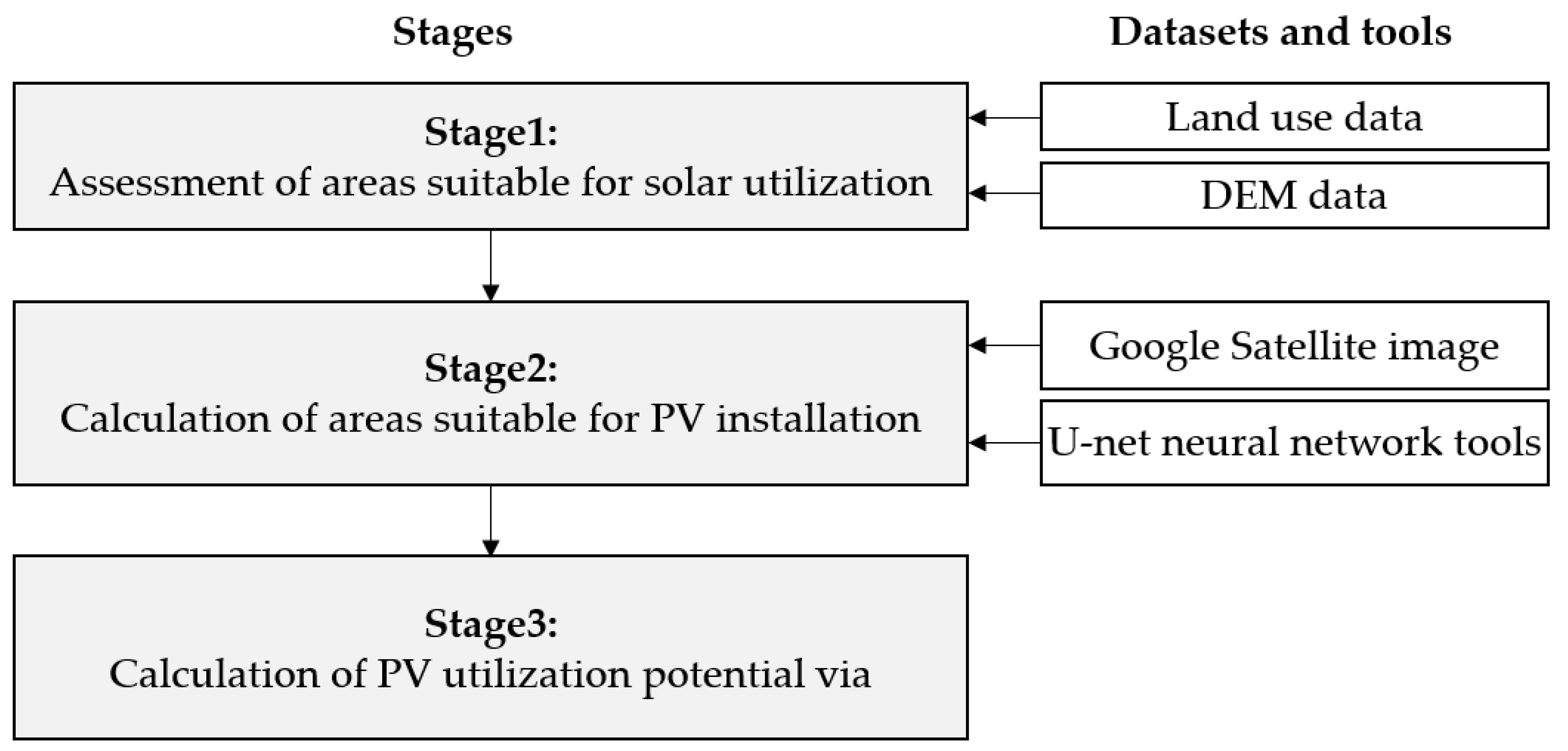
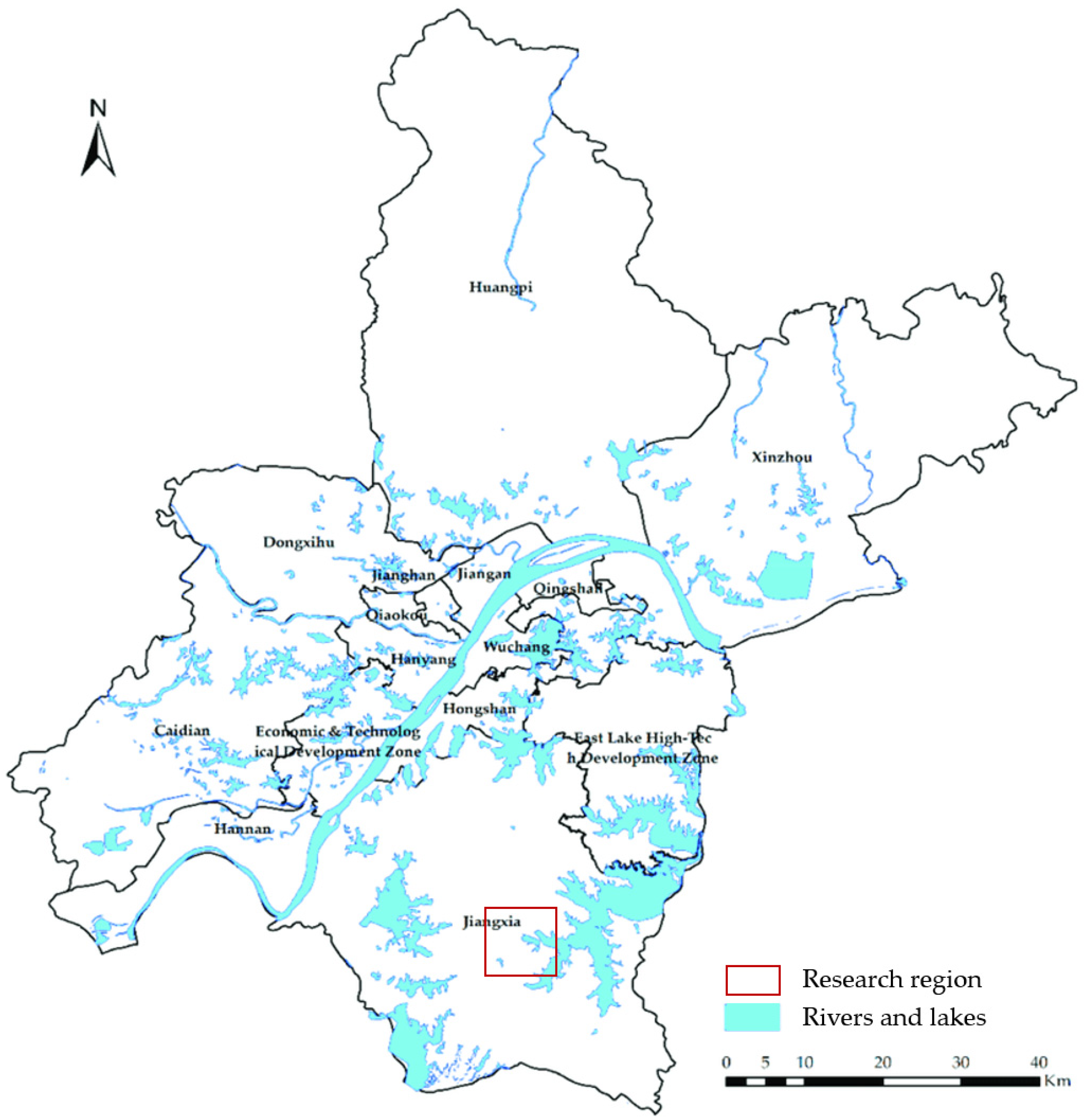
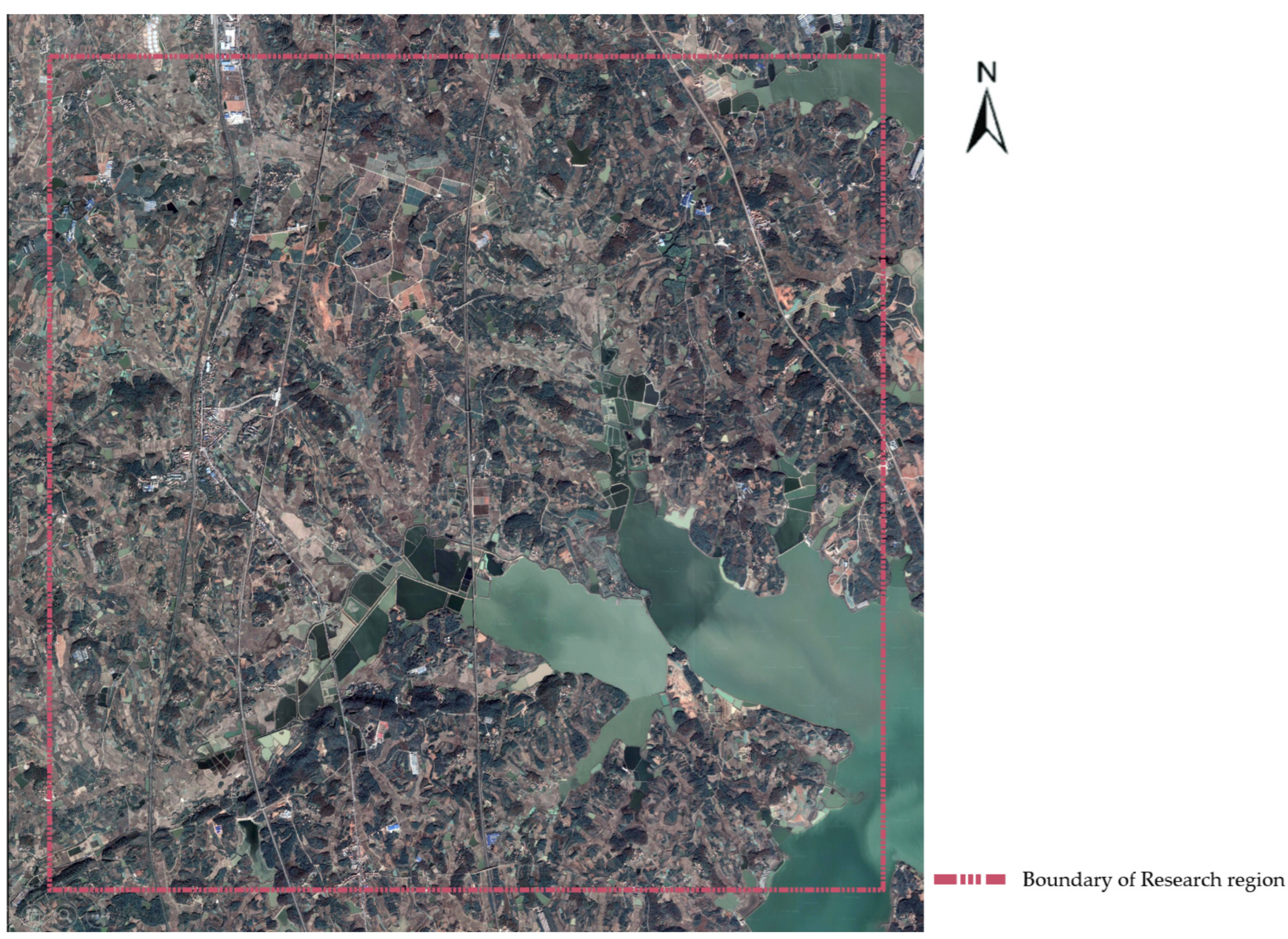
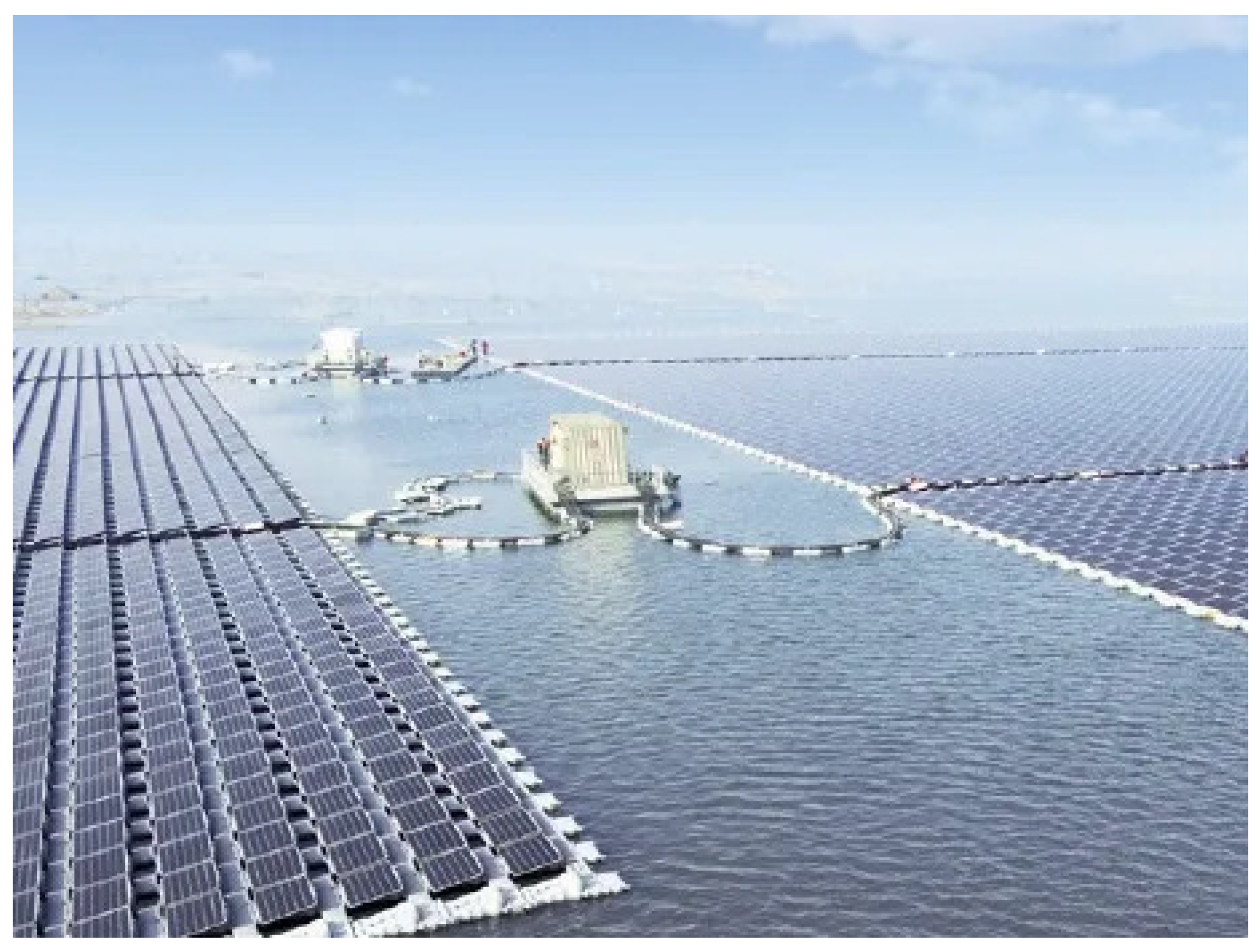

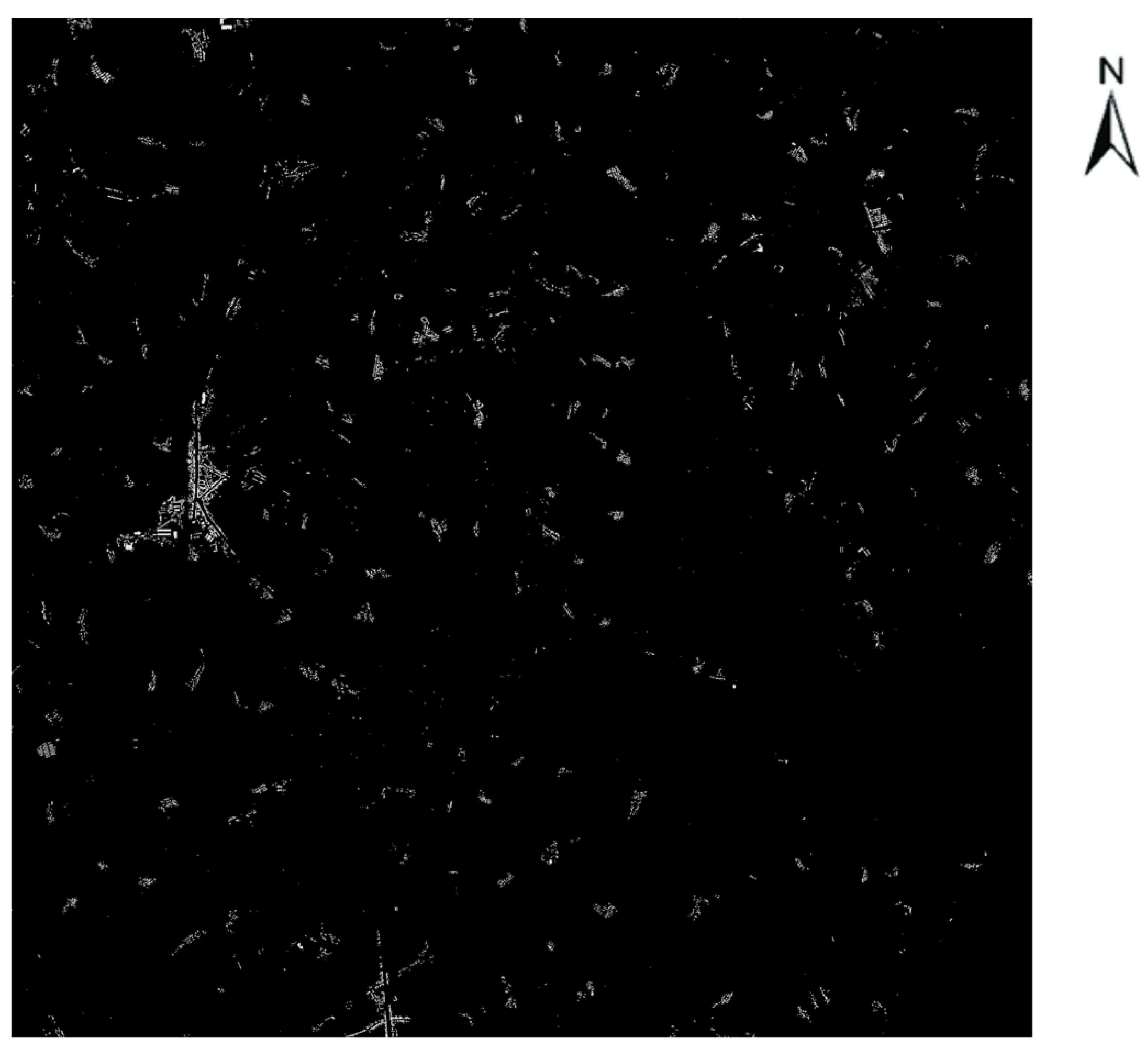

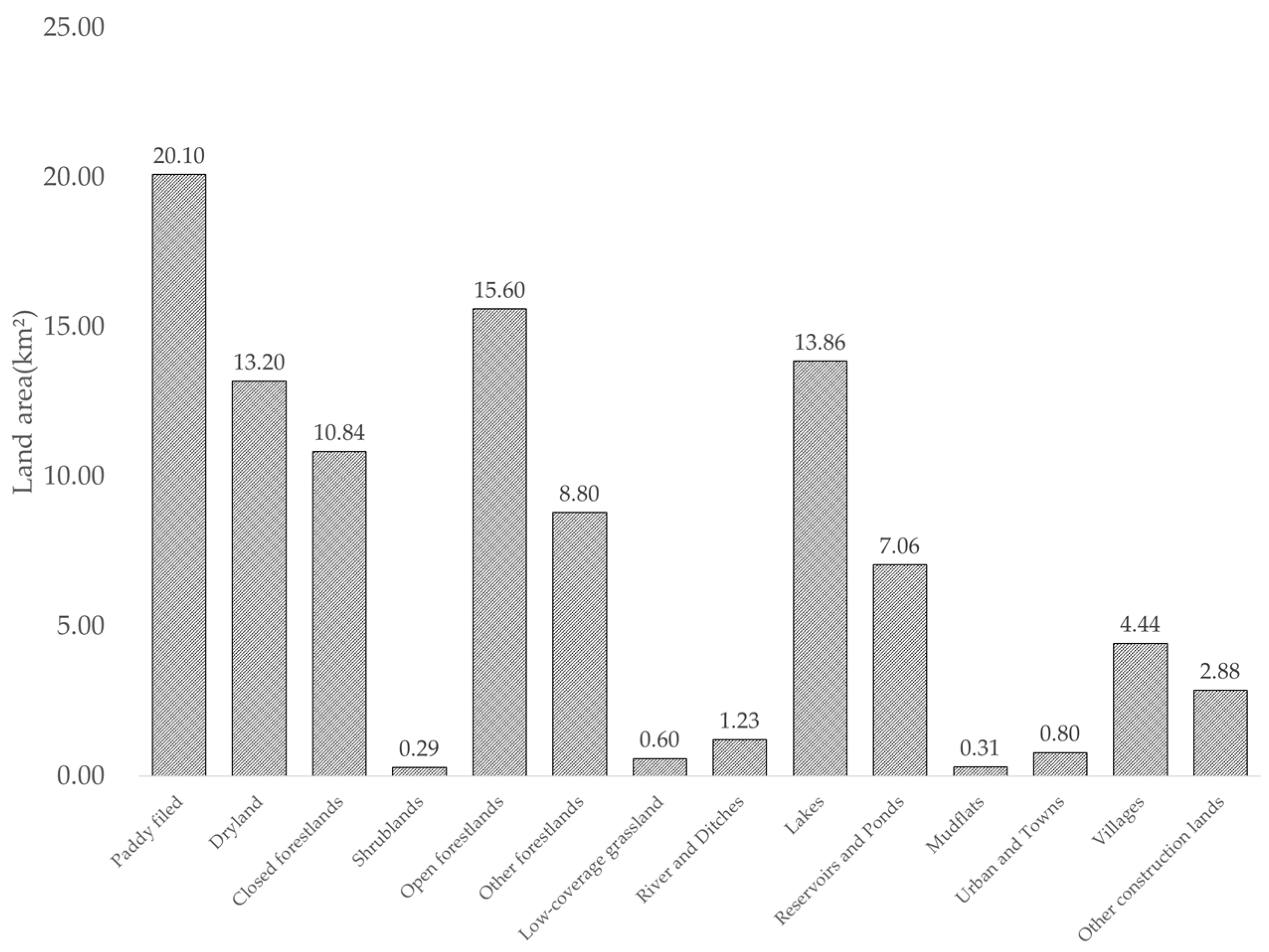
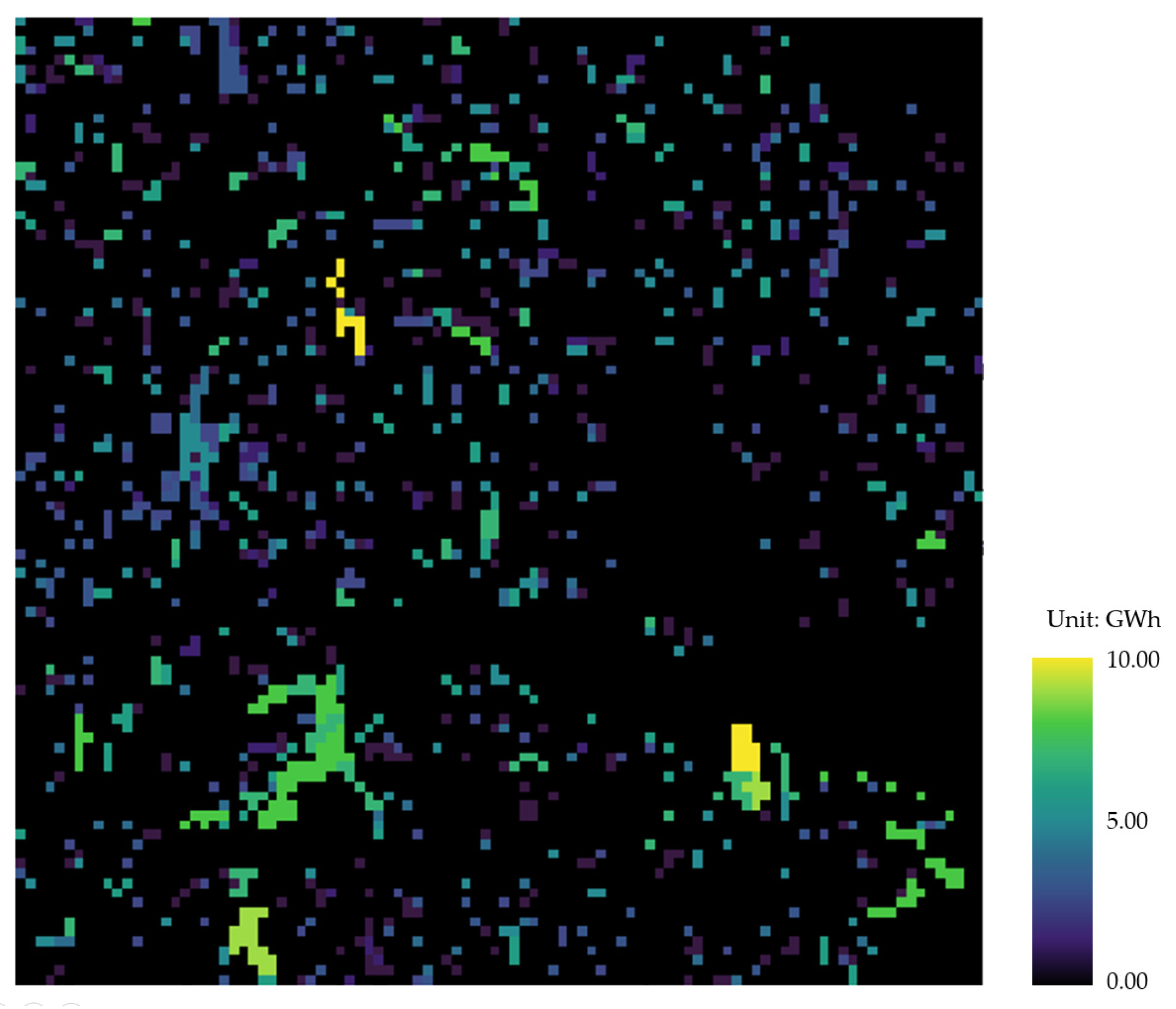

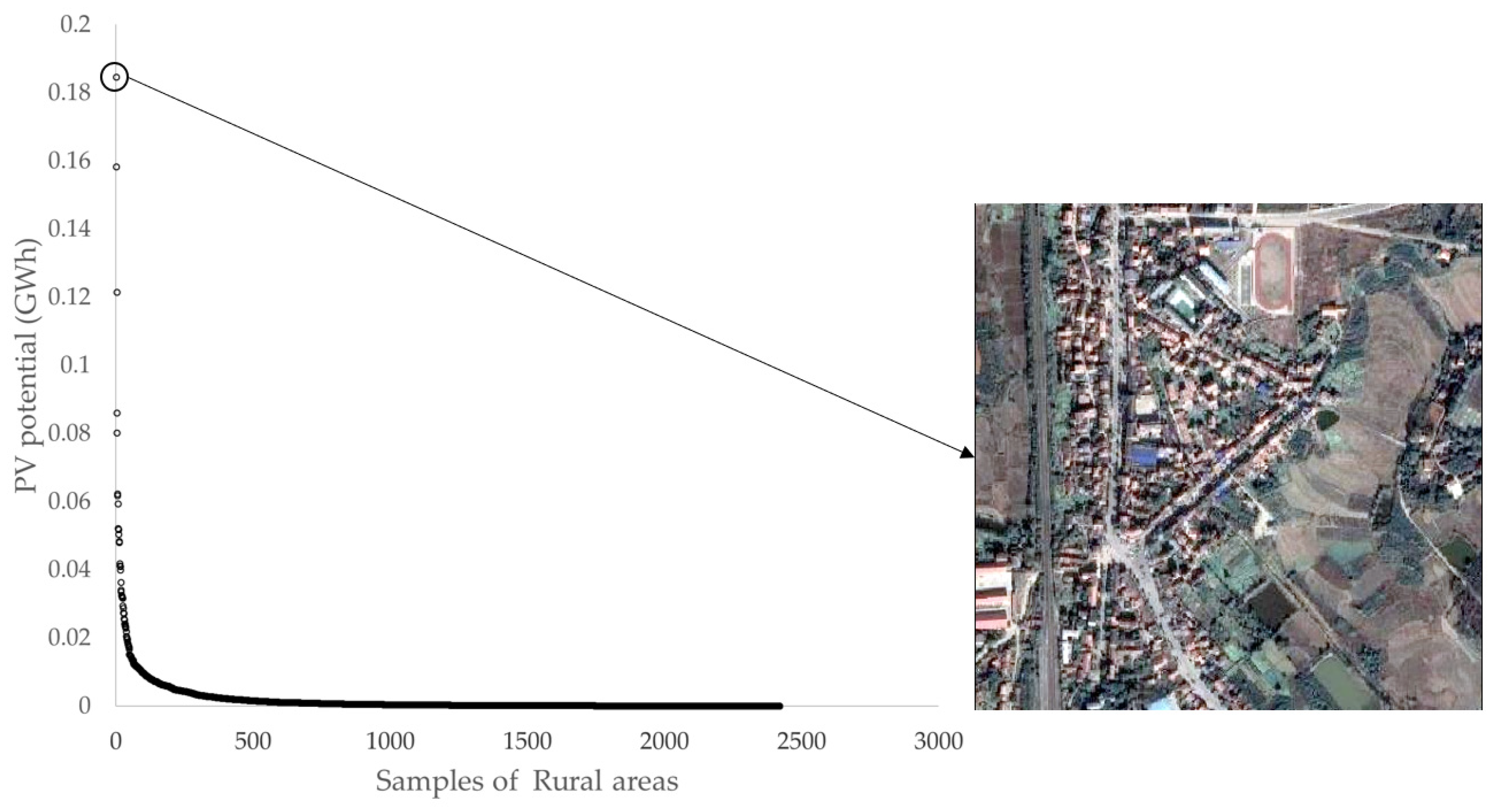
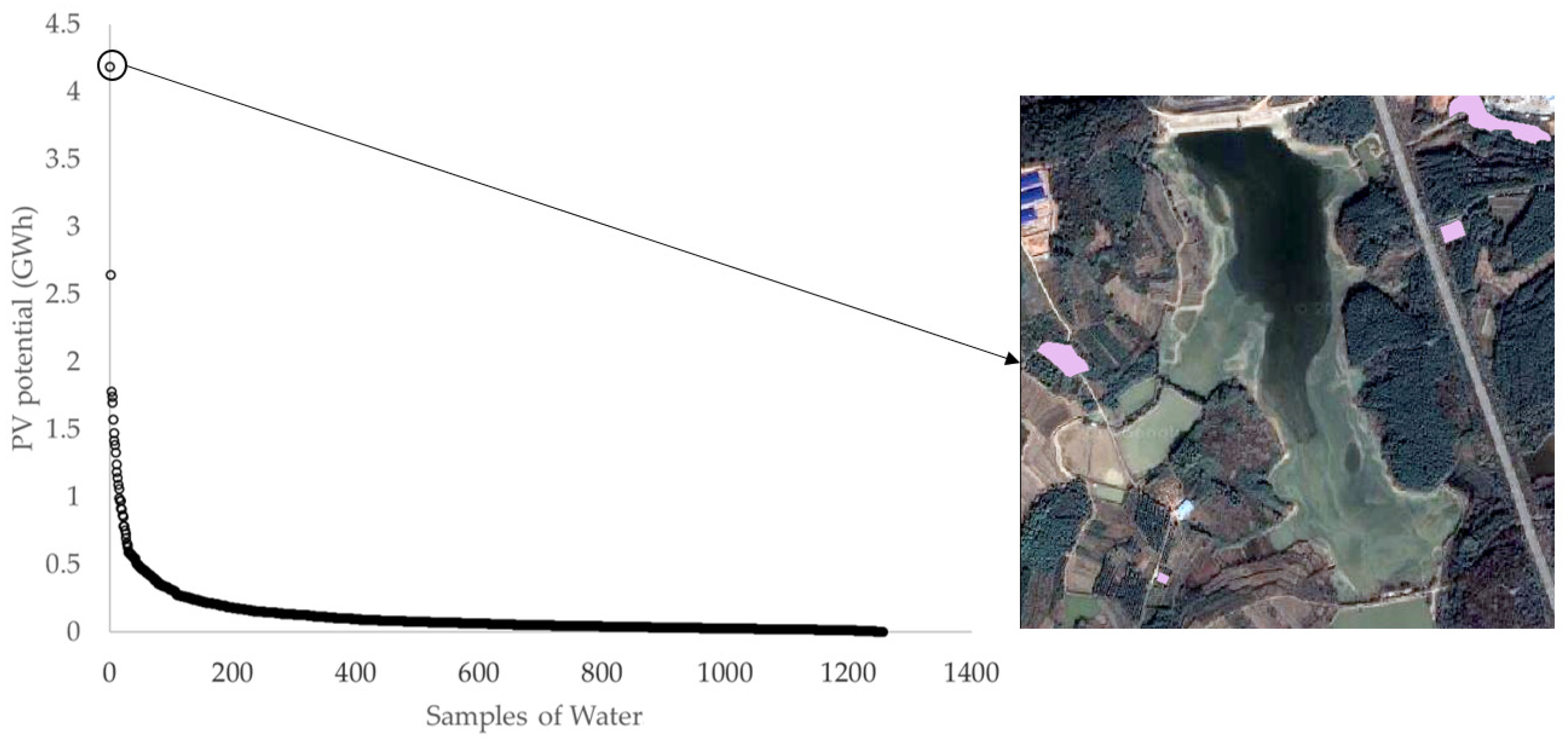
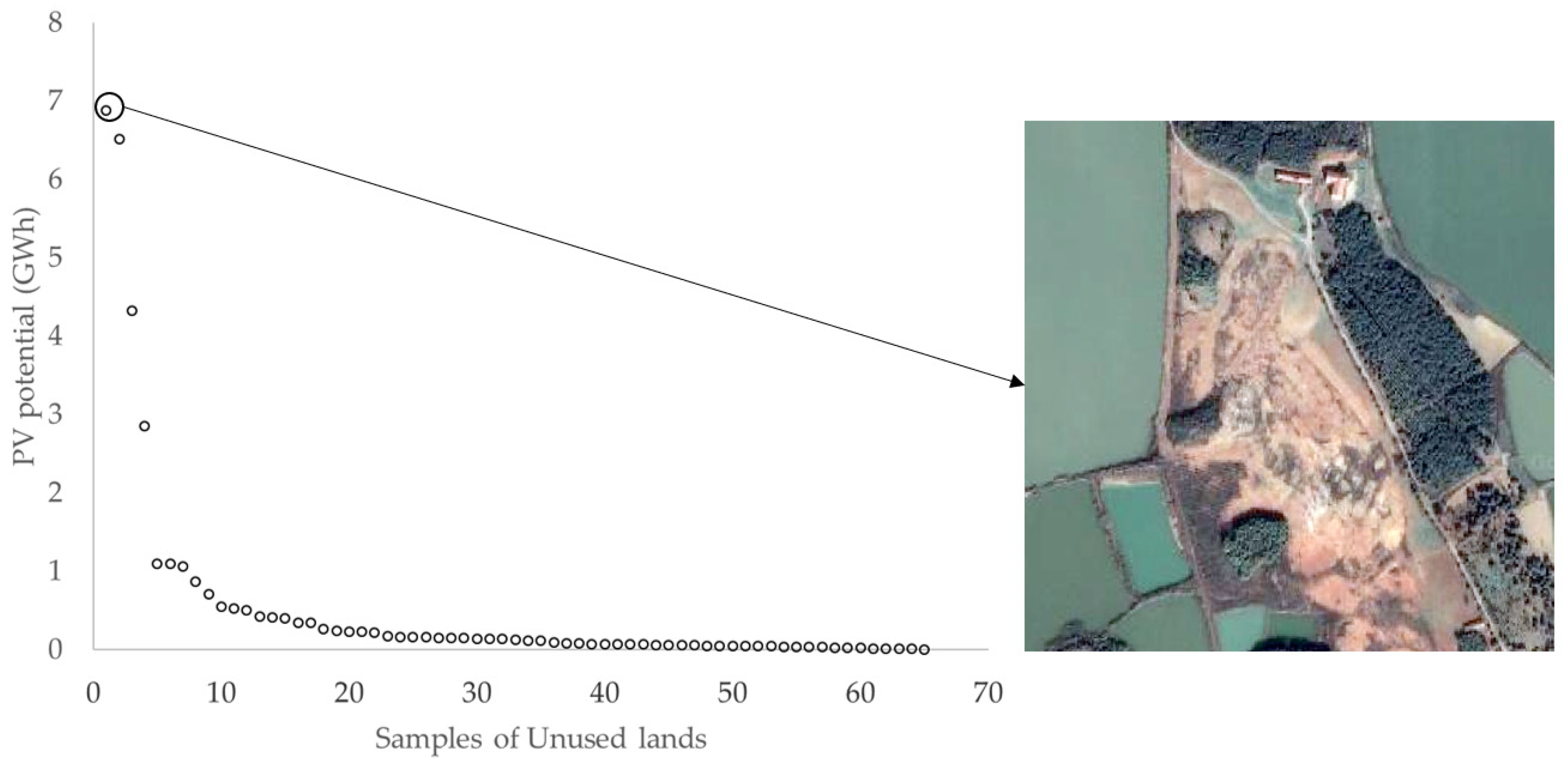
| Common Methods | Data Required | Assessment Scale | Calculation Speed | Calculation Accuracy | Research Heat |
|---|---|---|---|---|---|
| Empirical coefficient method | Statistical data such as roof surface ratio per capita population | City-level, national-level PV generation potential analysis | High calculation speed | Low precision | Due to the accuracy problem, few publications have been written in recent years |
| 3D model method | High-resolution LiDar or DSM data | City-level, community-level generation potential analysis | Low calculation speed | High precision for building façade and roof | Most of the studies have always been created with the help of national research data |
| Deep learning method | Easily obtainable free satellite images | Applicable to a flexible scale of PV generation potential analysis | High calculation speed | High precision for building roofs, but not façade information | It has arisen in recent years and is widely used in cities, but rarely in rural areas |
| Broad Category | Subcategory |
|---|---|
| Cultivated land | Paddy filed |
| Dryland | |
| Forestlands | Closed forestlands |
| Open forestlands | |
| Shrublands | |
| Other forestlands | |
| Grasslands | High-coverage grassland |
| Medium-coverage grassland | |
| Low-coverage grassland | |
| Waters | Rivers and ditches |
| Lakes | |
| Reservoirs and ponds | |
| Snow/ice | |
| Mudflats | |
| Urban, village and mining lands | Urban and towns |
| Villages | |
| Other construction land | |
| Unused land | Sandy areas |
| Gobi Desert | |
| Saline land | |
| Marshlands Bare exposed land | |
| Bare exposed rock or gravel |
| Location | |
|---|---|
| India | 35% |
| Bangladesh | 7.86% |
| China | 70% |
| Sultanate of Oman | 59.85% and 25.39% |
| PV Utilization Types | Applicable Land Types | PV Potential (GWh/year) | Percentage |
|---|---|---|---|
| BIPV | Rural areas | 4.69 | 2.37% |
| FSPV | Water | 159.91 | 83.75% |
| LSPV | Unused land | 33.43 | 168.88% |
| Total | —— | 198.02 | 100.00% |
| Land Types | Type | Area (km2) | PV Potential (GWh/year) | PV Potential per Unit Area (GWh/km2·year) |
|---|---|---|---|---|
| Rural areas | BIPV | 92.68 | 4.69 | 0.05 |
| Water | FSPV | 64.52 | 159.91 | 2.48 |
| Unused land | LSPV | 0.59 | 33.43 | 56.66 |
Disclaimer/Publisher’s Note: The statements, opinions and data contained in all publications are solely those of the individual author(s) and contributor(s) and not of MDPI and/or the editor(s). MDPI and/or the editor(s) disclaim responsibility for any injury to people or property resulting from any ideas, methods, instructions or products referred to in the content. |
© 2023 by the authors. Licensee MDPI, Basel, Switzerland. This article is an open access article distributed under the terms and conditions of the Creative Commons Attribution (CC BY) license (https://creativecommons.org/licenses/by/4.0/).
Share and Cite
Li, Z.; Zhang, C.; Yu, Z.; Zhang, H.; Jiang, H. Deep Learning Method for Evaluating Photovoltaic Potential of Rural Land Use Types. Sustainability 2023, 15, 10798. https://doi.org/10.3390/su151410798
Li Z, Zhang C, Yu Z, Zhang H, Jiang H. Deep Learning Method for Evaluating Photovoltaic Potential of Rural Land Use Types. Sustainability. 2023; 15(14):10798. https://doi.org/10.3390/su151410798
Chicago/Turabian StyleLi, Zhixin, Chen Zhang, Zejun Yu, Hong Zhang, and Haihua Jiang. 2023. "Deep Learning Method for Evaluating Photovoltaic Potential of Rural Land Use Types" Sustainability 15, no. 14: 10798. https://doi.org/10.3390/su151410798
APA StyleLi, Z., Zhang, C., Yu, Z., Zhang, H., & Jiang, H. (2023). Deep Learning Method for Evaluating Photovoltaic Potential of Rural Land Use Types. Sustainability, 15(14), 10798. https://doi.org/10.3390/su151410798






